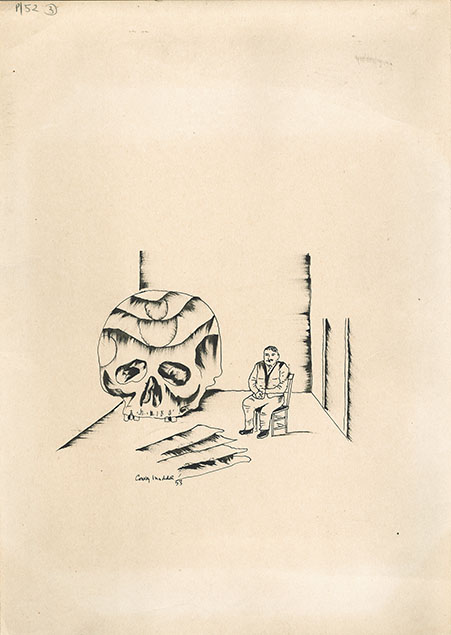(Ledbury, Herefordshire 1912 – London 2005)
SURREALIST COMPOSITION, 1953
Pen and ink on paper. Signed and dated in pen Conroy Maddox ’53.
295 x 210 mm.
A committed Surrealist for over seventy years, Conroy Maddox was a painter, writer and lecturer, and a key figure in the Birmingham Surrealist movement. He discovered surrealism in 1935, spending the rest of his life exploring its potential through his paintings, collages, photographs, objects and texts. Inspired by artists such as Max Ernst, Óscar Domínguez and Salvador Dalí, he rejected academic painting in favour of techniques that expressed the surrealistic spirit of rebellion. Maddox officially joined the British Surrealist Group in 1938. His creations soon began not only to challenge the conventional view of reality, but also to push pictorial expression to the limits of consciousness. Much of Maddox's work from the 1940s was influenced by that of his friends, including Man Ray and Hans Bellmer. As such, he developed a penchant for ready-mades, and in the subversive Onanistic Typewriter (1940), the keyboard of a typewriter is transformed into spikes. His paintings of the 1970s are of eerie, dreamlike images inspired by De Chirico and Magritte. Later he pioneered the water-based blotting technique of écrémage, which hark back to the earlier frottage experiments of Max Ernst. Maddox participated in many important survey shows of Surrealism, including Surrealist Masters at Acoris, the Surrealist Art Centre, London, and Dada and Surrealism Reviewed at the Hayward Gallery in 1978. More recently, Maddox was included in Surrealism, two private eyes, at the Guggenheim Museum, New York, and in Surrealism in Birmingham 1935-1954, alongside William Gear, Robert Melville and Desmond Morris, among others. In 2012, he featured alongside Brassai and Picabia, in an exhibition at Lille Métropole Musée d'Art Moderne, on the subject of dreams and fantasy.
